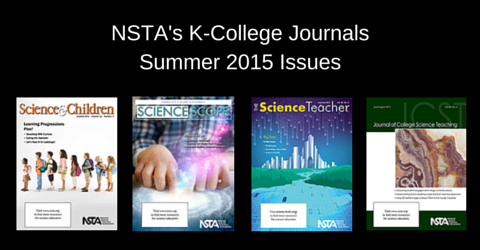NSTA’s K-College July 2015 Science Education Journals Online
By Lauren Jonas, NSTA Assistant Executive Director
Posted on 2015-07-05
Varied ways to use instructional sequences that support valid learning, making science accessible to all students, big data, and identifying textbooks or other reading materials that are written at the appropriate reading grade levels—these are the themes of the Summer 2015 journal articles from the National Science Teachers Association (NSTA). Browse through the thought-provoking selections below and learn more about families learning together, integrated STEM units, harvesting data, peer-led team learning, and other important topics in K–College science education.
Science and Children
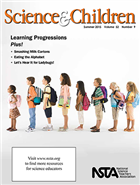 How much easier it would be, how much more learning would occur, and how much time we would save if all students brought the same background knowledge and skills to what they are learning? This issue of Science and Children employs the Next Generation of Science Standards (NGSS) to show the variety of ways in which you can use an instructional sequence that supports valid learning.
How much easier it would be, how much more learning would occur, and how much time we would save if all students brought the same background knowledge and skills to what they are learning? This issue of Science and Children employs the Next Generation of Science Standards (NGSS) to show the variety of ways in which you can use an instructional sequence that supports valid learning.
Featured articles (please note, only those marked “free” are available to nonmembers without a fee):
- Free – Dig Into Fossils!
- Eating the Alphabet
- Free – Editor’s Note: Identifying a Progression of Learning
- Families Learning Together
- Free – Guest Editorial: The Next Generation Science Standards: Where Are We Now and What Have We Learned?
- Let’s Hear It for Ladybugs!
- Smashing Milk Cartons
- Full Table of Contents
Science Scope
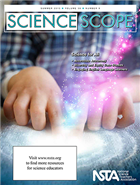 Making science accessible to all students should be the goal of every classroom science teacher. In this issue we share a variety of lessons you can use to overcome various socioeconomic, physical, and language barriers facing today’s students. We hope you can use these activities to help all of your students reach the stars.
Making science accessible to all students should be the goal of every classroom science teacher. In this issue we share a variety of lessons you can use to overcome various socioeconomic, physical, and language barriers facing today’s students. We hope you can use these activities to help all of your students reach the stars.
Featured articles (please note, only those marked “free” are available to nonmembers without a fee):
- Artificial Floating Islands: An Integrated STEM Unit
- Collaborative Concept Maps: A Voice for All Science Learners
- Free – Editor’s Roundtable: Charting a Course Toward NGSS Alignment
- Engineering Progressions in the NGSS Diversity and Equity Case Studies
- Science Meets Engineering: Applying the Design Process to Monitor Leatherback Turtle Hatchlings
- Supporting Science Access for All Students: Using Content Enhancements to Create Pathways to the Big Ideas
- The Fish Weir: A Culturally Relevant STEM Activity
- Free – The Next Generation Science Standards: Where Are We Now and What Have We Learned?
- Touching the Stars: Making Astronomy Accessible for Students With Visual Impairments
- Full Table of Contents
The Science Teacher
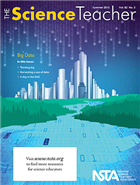 Ever-increasing volumes of information from sensors, satellites, cell phones, telescopes, global information systems, and social media provide unprecedented opportunities for scientists, citizens, and students to investigate complex systems. Scientific progress doesn’t result from simply accumulating data. But there’s no doubt that big data is revolutionizing fields as diverse as astronomy, marketing, genomics, climate science, oceanography, social science, and health care. Big data has the potential to transform science teaching and learning as well. Our students can engage in the higher-order thinking involved in analyzing and interpreting large science data sets and designing their own inquiries to discover patterns and meaning in mountains of accessible data, as authors in this issue of The Science Teacher illustrate.
Ever-increasing volumes of information from sensors, satellites, cell phones, telescopes, global information systems, and social media provide unprecedented opportunities for scientists, citizens, and students to investigate complex systems. Scientific progress doesn’t result from simply accumulating data. But there’s no doubt that big data is revolutionizing fields as diverse as astronomy, marketing, genomics, climate science, oceanography, social science, and health care. Big data has the potential to transform science teaching and learning as well. Our students can engage in the higher-order thinking involved in analyzing and interpreting large science data sets and designing their own inquiries to discover patterns and meaning in mountains of accessible data, as authors in this issue of The Science Teacher illustrate.
YouTube fans, watch high school science teacher and TST Field Editor, Steve Metz, introduce this month’s issue.
Featured articles (please note, only those marked “free” are available to nonmembers without a fee):
- Day in the Field
- Free – Editor’s Corner: Big Data
- Harvesting a Sea of Data
- Playing With Science
- Free – The Next Generation Science Standards: Where Are We Now and What Have We Learned?
- Free – Thinking Big
- Full Table of Contents
Journal of College Science Teaching
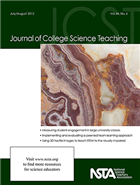 How do you handle the challenge of identifying textbooks or other reading materials that are written at the appropriate reading grade level yet still offer the desired content? See “Assessing the Readability of Geoscience Textbooks” to learn how one author assessed the readability of various materials to ensure that the text was not too challenging for students to comprehend. The Case Study article offers a detailed, step-by-step guide to helping students (and instructors) write case studies that are creative, well researched, and useful for teaching a topic to others. And don’t miss the Research and Teaching article that explores the effectiveness of incorporating 3D tactile images critical for learning STEM into entry-level lab courses for both sighted and vision-impaired students.
How do you handle the challenge of identifying textbooks or other reading materials that are written at the appropriate reading grade level yet still offer the desired content? See “Assessing the Readability of Geoscience Textbooks” to learn how one author assessed the readability of various materials to ensure that the text was not too challenging for students to comprehend. The Case Study article offers a detailed, step-by-step guide to helping students (and instructors) write case studies that are creative, well researched, and useful for teaching a topic to others. And don’t miss the Research and Teaching article that explores the effectiveness of incorporating 3D tactile images critical for learning STEM into entry-level lab courses for both sighted and vision-impaired students.
Featured articles (please note, only those marked “free” are available to nonmembers without a fee):
- Free – Are “New Building” Learning Gains Sustainable?
- Assessing the Readability of Geoscience Textbooks, Laboratory Manuals, and Supplemental Materials
- Collaboration-Focused Workshop for Interdisciplinary, Inter-Institutional Teams of College Science Faculty
- Implementing and Evaluating a Peer-Led Team Learning Approach in Undergraduate Anatomy and Physiology
- Research and Teaching: A New Tool for Measuring Student Behavioral Engagement in Large University Classes
- Research and Teaching: Aligning Assessment to Instruction: Collaborative Group Testing in Large-Enrollment Science Classes
- Research and Teaching: Methods for Creating and Evaluating 3D Tactile Images to Teach STEM Courses to the Visually Impaired
- Targeted Courses in Inquiry Science for Future Elementary School Teachers
- Using Popular Text to Develop Inquiry Projects: Supporting Preservice Teachers’ Knowledge of Disciplinary Literacy
- Full Table of Contents
Get these journals in your mailbox as well as your inbox—become an NSTA member!
Follow NSTA
Disclaimer: The views expressed in this blog post are those of the author(s) and do not necessarily reflect the official position of the National Science Teaching Association (NSTA).



